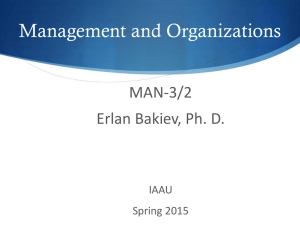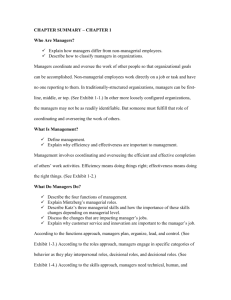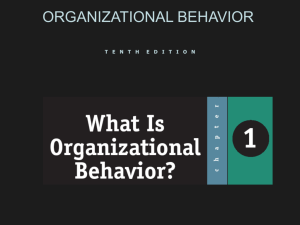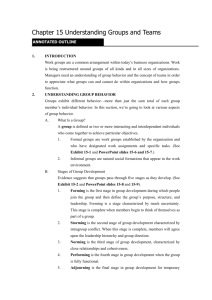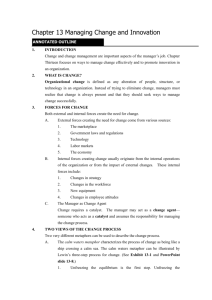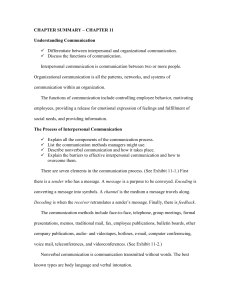Chapter 1 Introduction to Management and Organizations
advertisement
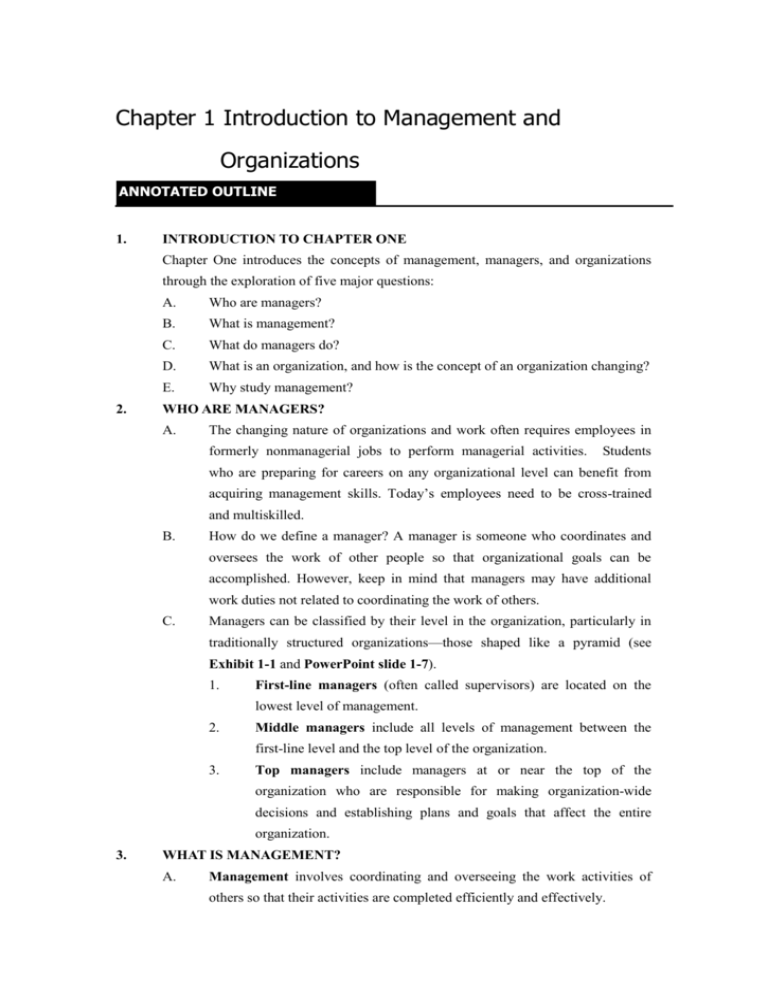
Chapter 1 Introduction to Management and Organizations ANNOTATED OUTLINE 1. INTRODUCTION TO CHAPTER ONE Chapter One introduces the concepts of management, managers, and organizations through the exploration of five major questions: 2. A. Who are managers? B. What is management? C. What do managers do? D. What is an organization, and how is the concept of an organization changing? E. Why study management? WHO ARE MANAGERS? A. The changing nature of organizations and work often requires employees in formerly nonmanagerial jobs to perform managerial activities. Students who are preparing for careers on any organizational level can benefit from acquiring management skills. Today’s employees need to be cross-trained and multiskilled. B. How do we define a manager? A manager is someone who coordinates and oversees the work of other people so that organizational goals can be accomplished. However, keep in mind that managers may have additional work duties not related to coordinating the work of others. C. Managers can be classified by their level in the organization, particularly in traditionally structured organizations—those shaped like a pyramid (see Exhibit 1-1 and PowerPoint slide 1-7). 1. First-line managers (often called supervisors) are located on the lowest level of management. 2. Middle managers include all levels of management between the first-line level and the top level of the organization. 3. Top managers include managers at or near the top of the organization who are responsible for making organization-wide decisions and establishing plans and goals that affect the entire organization. 3. WHAT IS MANAGEMENT? A. Management involves coordinating and overseeing the work activities of others so that their activities are completed efficiently and effectively. 1. Coordinating and overseeing the work of others is what distinguishes a managerial position from a nonmanagerial one. 2. Efficiency is getting the most output from the least amount of inputs in order to minimize resource costs. Efficiency is often referred to as “doing things right” (see Exhibit 1-2 and PowerPoint slide 1-9). 3. Effectiveness is completing activities so that organizational goals are attained and is often described as “doing the right things” (see Exhibit 1-2 and PowerPoint slide 1-9). 4. WHAT DO MANAGERS DO? No two managers’ jobs are exactly alike. But management writers and researchers have developed some specific categorization schemes to describe what managers do. Chapter One examines these three categorization schemes: functions, roles, skills. A. Management Functions. Henri Fayol, a French industrialist in the early 1900s, proposed that managers perform five management functions: POCCC (plan, organize, command, coordinate, control). 1. Over time, Fayol’s five management functions have been reorganized into four functions, which provide a foundation for the organization of many current management textbooks (see Exhibit 1-3 and PowerPoint slide 1-11). a. Planning involves defining goals, establishing strategies for achieving those goals, and developing plans to integrate and coordinate activities. b. Organizing involves arranging and structuring work to accomplish the organization’s goals. c. Leading involves working with and through people to accomplish organizational goals. d. Controlling involves monitoring, comparing, and correcting work performance. 2. In practice, managing is not always performed in a sequence as outlined above. Since these four management functions are integrated into the activities of managers throughout the workday, they should be viewed as an ongoing process. 3. The management process is the set of ongoing decisions and work activities in which managers engage as they plan, organize, lead, and control. B. Management Roles. In the late 1960s, Henry Mintzberg conducted a precise study of managers at work. He concluded that managers perform 10 different roles, which are highly interrelated. 1. Management roles refer to specific categories of managerial behavior (see Exhibit 1-4). a. Interpersonal roles include figurehead, leadership, and liaison activities. b. Informational roles include monitoring, disseminating, and spokesperson activities. c. Decisional roles include entrepreneur, disturbance handler, resource allocator, and negotiator. 2. Follow-up studies of Mintzberg’s role categories in different types of organizations and at different managerial levels within organizations generally support the idea that managers perform similar roles. 3. Although the functions approach represents the most useful way to describe the manager’s job, Mintzberg’s roles give additional insight into managers’ work. Some of the ten roles do not fall clearly into one of the four functions, since all managers do some work that is not purely managerial. C. Management Skills. Managers need certain skills to perform the challenging duties and activities associated with being a manager. 1. Robert L. Katz found through his research in the early 1970s that managers need three essential skills (see Exhibit 1-5 and PowerPoint slide 1-15). a. Technical skills are job-specific knowledge and techniques needed to proficiently perform specific tasks. b. Human skills are the ability to work well with other people individually and in a group. c. Conceptual skills are the ability to think and to conceptualize about abstract and complex situations. 2. Twenty-one skill-building modules appear at the back of the textbook following Chapter 19. These skills reflect a broad cross-section of the important managerial activities that are elements of the four management functions (see Exhibit 1-7). D. How the Manager’s Job Is Changing. Significant changes in the internal and external environments have a measurable impact on management. 1. Security threats, corporate ethics scandals, global economic and political uncertainties, and technological advancements should be discussed. E. Two significant changes facing today’s managers: 1. Importance of customers to the manager’s job 2. 5. Importance of innovation to the manager’s job WHAT IS AN ORGANIZATION? Organizations need managers. An organization is a deliberate arrangement of people to accomplish some specific purpose. A. Organizations share three common characteristics: (1) each has a distinct purpose; (2) each is composed of people; and (3) each develops some deliberate structure so members can do their work. (see Exhibit 1-9 and PowerPoint slide 1-25). B. Although these three characteristics are important in defining what an organization is, the concept of an organization is changing. Exhibit 1-10 and PowerPoint slide 1-26 list some important differences between the traditional organization and the new organization. These differences include: flexible work arrangements, employee work teams, open communication systems, and supplier alliances. Organizations are becoming more open, flexible, and responsive to changes. C. Organizations are changing because the world around them has changed and is continuing to change. These societal, economic, global, and technological changes have created an environment in which successful organizations must embrace new ways of getting their work done. 6. WHY STUDY MANAGEMENT? The importance of studying management in today’s dynamic global environment can be explained by looking at the universality of management, the reality of work, and the rewards and challenges of being a manager. A. The Universality of Management. Without a doubt, management is needed in all types and sizes of organizations, at all organizational levels, and in all organizational work areas throughout the world. 1. We interact with organizations each day of our lives. Every product we use, every action we take, is provided by or affected by organizations. Well-managed organizations develop a loyal customer base, grow, and prosper. 2. Students who study management gain the ability to recognize and encourage good management practices; just as important, they learn to recognize poor management and how to correct it. B. The Reality of Work. After graduation, students will either manage or be managed. A course in management provides insight and understanding about behaviors of supervisors and the internal operations of organizations. C. Rewards and Challenges of Being a Manager (see Exhibit 1-12) 1. Challenges a. Managers may have difficulty in effectively blending the knowledge, skills, ambitions, and experiences of a diverse group of employees. b. A manager’s success typically is dependent on others’ work performance. 2. Rewards a. Managers have an opportunity to create a work environment in which organizational members can do their work to the best of their ability and help the organization achieve its goals. b. Managers often receive recognition and status in the organization and in the larger community; influence organizational outcomes; and receive appropriate compensation. c. Knowing that their efforts, skills, and abilities are needed by the organization gives many managers great satisfaction.
